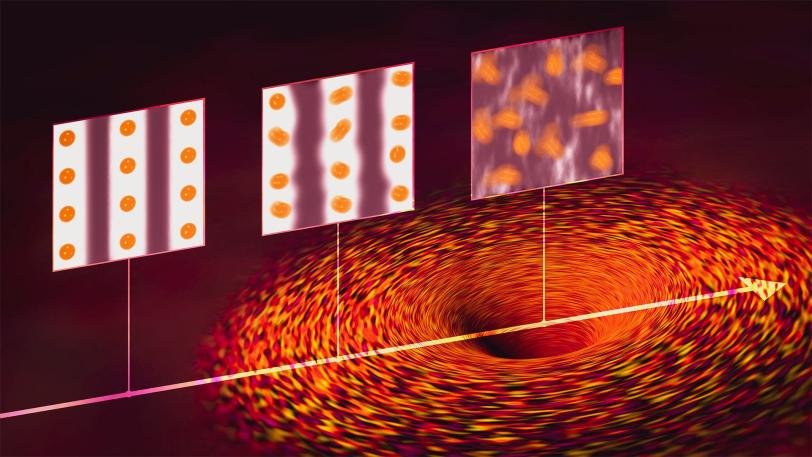SLAC researchers find evidence for quantum fluctuations near a quantum critical point in a superconductor
Theory suggests that quantum critical points may be analogous to black holes as places where all sorts of strange phenomena can exist in a quantum material. Now scientists are trying to pin down where this particular quantum critical point might be.
By Glennda Chui
Among all the curious states of matter that can coexist in a quantum material, jostling for preeminence as temperature, electron density and other factors change, some scientists think a particularly weird juxtaposition exists at a single intersection of factors, called the quantum critical point or QCP.
“Quantum critical points are a very hot issue and interesting for many problems,” says Wei-Sheng Lee, a staff scientist at the Department of Energy’s SLAC National Accelerator Laboratory and investigator with the Stanford Institute for Materials and Energy Sciences (SIMES). “Some suggest that they’re even analogous to black holes in the sense that they are singularities – point-like intersections between different states of matter in a quantum material – where you can get all sorts of very strange electron behavior as you approach them.”
Lee and his collaborators reported in Nature Physics today that they have found strong evidence that QCPs and their associated fluctuations exist. They used a technique called resonant inelastic X-ray scattering (RIXS) to probe the electronic behavior of a copper oxide material, or cuprate, that conducts electricity with perfect efficiency at relatively high temperatures.

These so-called high-temperature superconductors are a bustling field of research because they could give rise to zero-waste transmission of energy, energy-efficient transportation systems and other futuristic technologies, although no one knows the underlying microscopic mechanism behind high-temperature superconductivity yet. Whether QCPs exist in cuprates is also a hotly debated issue.
In experiments at the UK’s Diamond Light Source, the team chilled the cuprate to temperatures below 90 kelvins (minus 183 degrees Celsius), where it became superconducting. They focused their attention on what’s known as charge order – alternating stripes in the material where electrons and their negative charges are denser or more sparse.
The scientists excited the cuprate with X-rays and measured the X-ray light that scattered into the RIXS detector. This allowed them to map out how the excitations propagated through the material in the form of subtle vibrations, or phonons, in the material’s atomic lattice, which are hard to measure and require very high-resolution tools.
At the same time, the X-rays and the phonons can excite electrons in the charge order stripes, causing the stripes to fluctuate. Since the data obtained by RIXS reflects the coupling between the behavior of the charge stripes and the behavior of the phonons, observing the phonons allowed the researchers to measure the behavior of the charge order stripes, too.
What the scientists expected to see is that when the charge order stripes grew weaker, their excitations would also fade away. “But what we observed was very strange,” Lee said. “We saw that when charge order became weaker in the superconducting state, the charge order excitations became stronger. This is a paradox because they should go hand in hand, and that’s what people find in other charge order systems.”
He added, “To my knowledge this is the first experiment about charge order that has shown this behavior. Some have suggested that this is what happens when a system is near a quantum critical point, where quantum fluctuations become so strong that they melt the charge order, much like heating ice increases thermal vibrations in its rigid atomic lattice and melts it into water. The difference is that quantum melting, in principle, occurs at zero temperature.” In this case, Lee said, the unexpectedly strong charge order excitations seen with RIXS were manifestations of those quantum fluctuations.
Lee said the team is now studying these phenomena at a wider range of temperatures and at different levels of doping – where compounds are added to change the density of freely moving electrons in the material – to see if they can nail down exactly where the quantum critical point could be in this material.
Thomas Devereaux, a theorist at SIMES and senior author of the report, noted that many phases of matter can be intertwined in cuprates and other quantum materials.
“Superconducting and magnetic states, charge order stripes and so on are so entangled that you can be in all of them at the same time,” he said. “But we’re stuck in our classical way of thinking that they have to be either one way or another.”
Here, he said, “We have an effect, and Wei-Sheng is trying to measure it in detail, trying to see what’s going on.”
Ke-Jin Zhou of the Diamond Light Source co-led the experiments there, with cuprate samples provided by scientists at the National Institute of Advanced Industrial Science and Technology (AIST) in Japan. Researchers from SLAC’s Stanford Synchrotron Radiation Lightsource (SSRL), which is a DOE Office of Science user facility; Stanford University; and Leiden University in the Netherlands also contributed to this research, which was funded by the DOE Office of Science.
Citation: Wei-Sheng Lee et al., Nature Physics, 31 August 2020 (10.1038/s41567-020-0993-7)
Contact
For questions or comments, contact the SLAC Office of Communications at communications@slac.stanford.edu.
SLAC is a vibrant multiprogram laboratory that explores how the universe works at the biggest, smallest and fastest scales and invents powerful tools used by scientists around the globe. With research spanning particle physics, astrophysics and cosmology, materials, chemistry, bio- and energy sciences and scientific computing, we help solve real-world problems and advance the interests of the nation.
SLAC is operated by Stanford University for the U.S. Department of Energy’s Office of Science. The Office of Science is the single largest supporter of basic research in the physical sciences in the United States and is working to address some of the most pressing challenges of our time.





